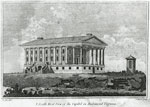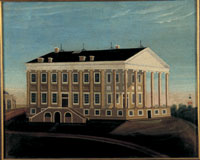Temple on the Hill
For more than 150 years, the Virginia State Capitol on Shockoe Hill dominated the Richmond skyline. Writers and artists commented on its presence and its condition. The works by artists before the advent of photography provide information, often inaccurate, about the building and its setting. Photographers documented the State Capitol in the years between the Civil War and the expansion of 1904-1906.
Artist Lawrence Sully (1769-1804) drew this view of the State Capitol showing Samuel Dobie's side stairs. Robert Gilmor of Baltimore, in 1806 called the stairs "Gothic," meaning bizarre and unaesthetic. After 1816, Maximilian Godefroy remodeled the stairs to resemble more closely what Jefferson intended.

Click to Enlarge
State Capitol. Lawrence Sully.
Digital reproduction of wood engraving.
Published in Virginia & North Carolina Almanack 1802.
In this view of the State Capitol, painted by Howard W. Montague, a Baptist minister from Essex County, the building's exterior paint scheme is clear. The colors of the Capitol varied from grays to tan to brown throughout much of the 1800s. The Capitol became a white building late in the 19th century.

Virginia State Capitol
Howard W. Montague. Before 1858. Oil on canvas.
Library of Virginia.